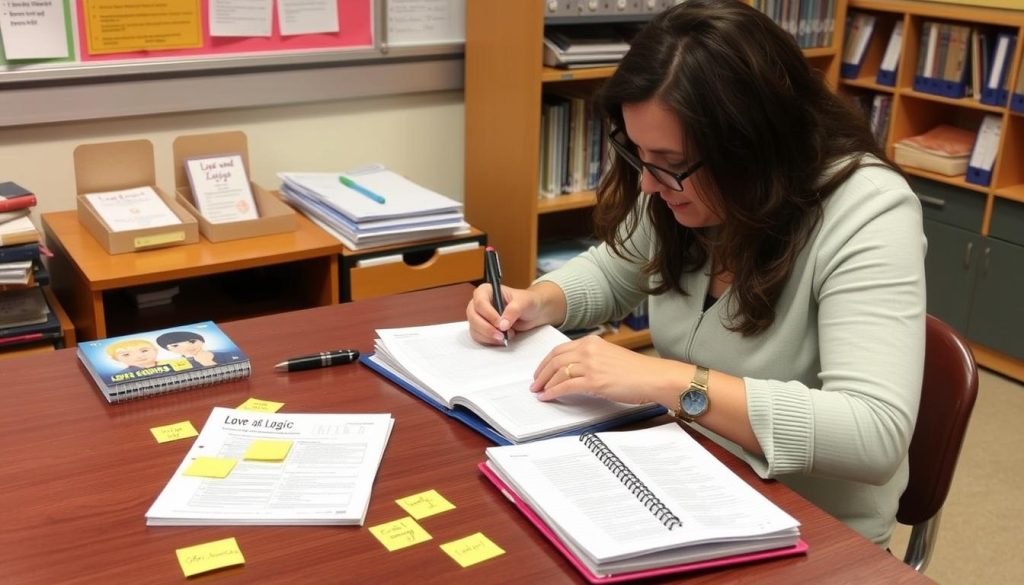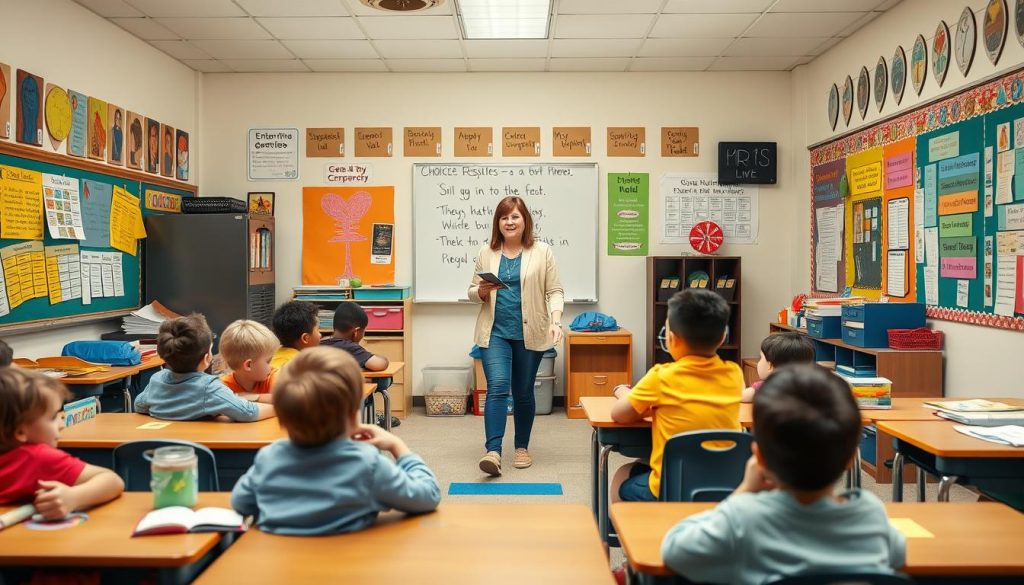Understanding Key Management Theories: The Love and Logic Approach
Love and Logic emphasizes positive relationships while maintaining clear boundaries
Love and Logic is a classroom management philosophy developed by Jim Fay and Foster W. Cline that balances warmth with firm boundaries. At its core, this approach combines empathy (“Love”) with natural consequences (“Logic”) to help students develop responsibility for their actions. Unlike traditional disciplinary methods that rely heavily on punishment, Love and Logic focuses on helping children make good decisions through guided choices and experiencing the natural results of those choices.
The foundation of Love and Logic rests on several key principles that distinguish it from other management theories:
- Shared control – giving students appropriate choices within limits
- Shared thinking – encouraging students to solve their own problems
- Equal doses of empathy and consequences
- Maintaining the child’s self-concept
These principles align with broader educational psychology research that shows students learn best when they feel both emotionally safe and accountable for their actions. According to a 2018 study on classroom management standards, approaches that balance relationship-building with clear expectations show the most promising outcomes for student behavior and academic achievement.
Developing these teacher skills requires practice and a deep understanding of how children respond to different management approaches. By mastering the Love and Logic framework, you’ll add valuable techniques to your professional toolkit that can serve you throughout your teaching career.
Core Principles of Love and Logic in Classroom Management
To effectively implement Love and Logic, teachers need to understand its foundational principles. These core concepts work together to create a classroom environment where students learn responsibility while feeling valued and respected.

Empathy combined with natural consequences helps students learn from their choices
1. Shared Control Through Choices
Rather than engaging in power struggles, Love and Logic teachers share control by offering limited, appropriate choices. This approach recognizes that everyone needs some sense of control over their lives, including children. By providing small choices throughout the day, teachers satisfy this need while maintaining necessary boundaries.
“Control with anger creates rebellion. Control with choices creates responsibility.”
Jim Fay, Co-founder of Love and Logic
Effective teacher skills include knowing how to frame choices properly. Each option should be acceptable to you as the teacher, and choices should be offered before problems arise, not during conflicts. This preventative approach is key to understanding key management theories that emphasize proactive rather than reactive discipline.
2. Empathy Before Consequences
When students make poor choices, Love and Logic teachers respond first with genuine empathy, then allow appropriate consequences to occur. This powerful combination teaches that mistakes are opportunities for growth rather than occasions for punishment.
Expressing authentic empathy before delivering consequences helps maintain the student-teacher relationship while still holding students accountable. This balance is crucial for developing teacher skills that foster both emotional connection and responsible behavior.
3. Shared Thinking and Problem-Solving
Love and Logic encourages teachers to guide students in thinking through problems rather than solving everything for them. By asking thoughtful questions and allowing students time to process, teachers help develop critical thinking skills and personal responsibility.
Questions like “What do you think you might do about that?” or “How do you think that might work out for you?” prompt students to engage in problem-solving rather than depending on adults for all solutions.
4. Building Self-Concept
A cornerstone of Love and Logic is preserving and enhancing students’ self-concept. This means separating the deed from the doer—addressing problematic behaviors while affirming the inherent value of each child.
Teachers who master these essential teacher skills create classrooms where students feel safe to make mistakes and learn from them, fostering both academic growth and emotional well-being.
Practical Examples of Love and Logic in Action
Understanding key management theories like Love and Logic becomes much clearer when we see them applied in real classroom situations. Here are practical examples that demonstrate how these principles work with different age groups and scenarios.

Offering meaningful choices helps students develop decision-making skills
Elementary School Examples
Scenario: Incomplete Homework
Traditional Approach: “You didn’t do your homework again? That’s a zero and a note home.”
Love and Logic Approach: “I notice your homework isn’t complete. That’s sad. Would you like to use some of your recess time to finish it, or would you prefer to take it home and bring it completed tomorrow? Either way, I know you’ll figure out a good solution.”
This response demonstrates empathy while offering reasonable choices and natural consequences, building teacher skills in managing academic responsibilities without creating power struggles.
Scenario: Classroom Disruption
Traditional Approach: “Stop talking and pay attention right now!”
Love and Logic Approach: “I teach when there aren’t disruptions. You’re welcome to join us in learning, or you can sit at the thinking desk until you’re ready. You decide.”
This approach shares control while maintaining clear boundaries, an essential teacher skill for managing classroom behavior effectively.
Middle School Examples
Scenario: Late to Class
Traditional Approach: “You’re late again! That’s a detention.”
Love and Logic Approach: “Glad you made it. We’ve already started the activity. You can catch up during study hall or after school today. What works best for you?”
This response acknowledges the situation without embarrassing the student while still maintaining expectations—a valuable teacher skill for working with adolescents.
Scenario: Group Work Conflicts
Traditional Approach: “I’ll reassign groups since you can’t work together.”
Love and Logic Approach: “I notice your group is having some challenges. What solutions have you tried so far? What might work better? I’m happy to hear your ideas when you’ve had a chance to brainstorm some options.”
This encourages problem-solving skills while offering support—balancing guidance with student autonomy.
High School Examples
Scenario: Phone Use During Class
Traditional Approach: “Give me your phone now. You can get it back at the end of the day.”
Love and Logic Approach: “In this class, phones are either in backpacks or in the phone pocket chart. Would you prefer to put it away now or would you like me to keep it safe until the end of class?”
This offers appropriate choices while maintaining classroom expectations—a key teacher skill for managing technology distractions.
Scenario: Missing Assignment Deadline
Traditional Approach: “No late work accepted. That’s a zero.”
Love and Logic Approach: “I accept assignments until the end of the unit for partial credit. You’ll need to complete the late work form explaining your plan for meeting future deadlines. Would you like the form now or at the end of class?”
This maintains academic standards while teaching responsibility and planning—important teacher skills for preparing students for college and careers.
Ready to Transform Your Classroom Management Approach?
Discover comprehensive strategies and techniques for implementing Love and Logic in your classroom. Our specialized course provides step-by-step guidance for K-12 teachers.
Understanding Key Management Theories: How Love and Logic Compares
To fully appreciate Love and Logic, it helps to understand how it relates to other prominent classroom management theories. Each approach offers valuable insights, and many teachers develop their own hybrid style drawing from multiple frameworks.
Different management theories emphasize various aspects of teacher-student interaction
Love and Logic
- Emphasizes natural and logical consequences
- Focuses on shared control through choices
- Prioritizes empathy before consequences
- Encourages student problem-solving
- Maintains positive relationship during discipline
Positive Behavioral Interventions & Supports (PBIS)
- Uses tiered support system
- Emphasizes explicit teaching of expectations
- Focuses on positive reinforcement
- Data-driven decision making
- School-wide consistent approach
Assertive Discipline (Lee Canter)
- Clear rules and expectations
- Consistent consequences for misbehavior
- Emphasis on teacher authority
- Structured response system
- Recognition for appropriate behavior
Understanding key management theories helps teachers develop a comprehensive approach that can adapt to different situations and student needs. The most effective educators develop teacher skills that allow them to draw from multiple frameworks, selecting strategies that best fit their teaching style and classroom dynamics.
While some approaches like Assertive Discipline focus more on teacher authority and clear consequences, and PBIS emphasizes systematic positive reinforcement, Love and Logic uniquely balances relationship-building with student accountability through natural consequences.
Research suggests that teachers who understand multiple management theories are better equipped to handle diverse classroom challenges. According to a 2019 study in the Journal of Education for Teaching, teachers who can flexibly apply different management approaches report higher job satisfaction and student engagement.
Implementing Love and Logic: Practical Steps for Teachers
Transitioning to a Love and Logic approach requires intentional practice and patience. Here’s a step-by-step guide to help you implement these principles in your classroom while developing essential teacher skills.

Thoughtful planning helps ensure successful implementation of Love and Logic principles
- Start with self-reflection
Examine your current management style and identify areas where you tend to take too much control or avoid setting necessary limits. - Begin with one principle
Rather than overhauling your entire approach, start by implementing one aspect of Love and Logic, such as offering more choices or responding with empathy first. - Practice empathetic responses
Develop a repertoire of empathetic statements like “That’s tough” or “I can see this is frustrating” to use before addressing consequences. - Create a bank of choice statements
Prepare choice options for common classroom situations so you’re ready to offer appropriate choices rather than commands. - Identify natural consequences
Consider the natural outcomes of common student behaviors so you can allow these consequences to teach rather than imposing unrelated punishments. - Communicate with parents
Share your approach with families so they understand the philosophy behind your management style. - Be consistent but patient
Consistency is key, but remember that students accustomed to other approaches may need time to adjust to having more responsibility.
Developing these teacher skills takes time and practice. Many educators find that joining professional learning communities or taking specialized courses helps them master the nuances of Love and Logic implementation.
Pro Tip: Keep a reflection journal during your first few weeks of implementing Love and Logic. Note which strategies worked well and which situations were challenging. This self-assessment will help you refine your approach and build confidence in your teacher skills.
Understanding key management theories like Love and Logic is just the beginning—the real learning comes through consistent application and reflection on outcomes. As you become more comfortable with these principles, you’ll likely find yourself naturally incorporating them into your teaching style.
Common Challenges and Solutions When Implementing Love and Logic
Even with a solid understanding of key management theories, implementing Love and Logic can present challenges. Here are common obstacles teachers face and practical solutions to overcome them.

Maintaining composure during challenges is a crucial teacher skill when implementing Love and Logic
Challenge: Students testing boundaries after implementation
Why it happens: When shifting to a new management approach, students often test to see if the new boundaries are firm.
Solution: Remain consistent and calmly enforce the natural consequences. Avoid reverting to old patterns during testing phases. Remember that temporary increases in challenging behavior often precede improvement as students adjust to new expectations.
Challenge: Difficulty generating appropriate choices in the moment
Why it happens: Under pressure, it can be hard to think of reasonable choices that both satisfy the need for student autonomy and maintain necessary boundaries.
Solution: Create a “choice bank” for common situations. Practice phrasing choices ahead of time so they become second nature. Remember that simple choices work best: “Would you prefer to work quietly at your desk or at the back table?”
Challenge: Balancing empathy with accountability
Why it happens: Some teachers worry that showing empathy might be perceived as condoning misbehavior.
Solution: Remember that empathy doesn’t mean approval—it acknowledges feelings without endorsing actions. Practice phrases like “I can see you’re upset. I would be too. And, the rule about respectful language still stands.”
Challenge: Resistance from colleagues or administration
Why it happens: School cultures often have established discipline approaches, and deviation can cause friction.
Solution: Share research supporting Love and Logic. Invite interested colleagues to observe your classroom. Document positive outcomes to demonstrate effectiveness. Consider proposing a pilot program or professional development opportunity.
Challenge: Parent concerns about the approach
Why it happens: Parents may be accustomed to traditional discipline methods and question an approach that emphasizes student choice and natural consequences.
Solution: Communicate the philosophy clearly at the beginning of the year. Share success stories and research. Consider hosting a parent information session about your classroom management approach.
Developing teacher skills to navigate these challenges is part of the growth process when implementing any new management approach. With practice, the principles of Love and Logic become more intuitive, allowing you to respond effectively even in challenging situations.
For more detailed strategies on overcoming implementation challenges, many teachers find it helpful to connect with others using the same approach through professional development communities or specialized courses.
Case Studies: Love and Logic Success Stories
Understanding key management theories in action helps visualize their real-world impact. These case studies demonstrate how teachers have successfully implemented Love and Logic principles to transform challenging classroom situations.
Consistent implementation of Love and Logic principles can transform classroom dynamics
Case Study 1: Elementary Classroom Transformation
“After 15 years of teaching, I was burning out from constant power struggles with my third graders. Implementing Love and Logic completely changed my classroom culture. By offering choices and responding with empathy, I saw dramatic improvements in student behavior and my own job satisfaction.”
Maria L., 3rd Grade Teacher
Key Changes Implemented:
- Replaced commands with choice statements
- Responded to misbehavior with empathy before consequences
- Created a “thinking spot” for students to problem-solve
- Used enforceable statements (“I teach when there are no disruptions”)
Results: Within two months, office referrals decreased by 60%. Student surveys showed increased perception of classroom fairness and teacher caring. Parent feedback was overwhelmingly positive, with several requesting information about using similar approaches at home.
Case Study 2: Middle School Behavior Challenges
“My eighth-grade class had a reputation for being ‘difficult.’ Rather than tightening control, I implemented Love and Logic principles, particularly shared thinking and problem-solving. The transformation was remarkable—students began taking ownership of their behavior and academic work.”
James T., 8th Grade Science Teacher
Key Changes Implemented:
- Implemented class problem-solving meetings
- Used the “energy drain” concept for disruptive behavior
- Created a recovery area for emotional regulation
- Developed a peer mediation program based on Love and Logic principles
Results: Class participation increased by 40%. Students reported feeling more respected and engaged. Academic performance improved, with the class average rising from C to B- over one semester. Teacher stress levels decreased significantly.
These case studies highlight how understanding key management theories and developing specific teacher skills can transform classroom dynamics. While individual results may vary, the consistent application of Love and Logic principles typically leads to improved student behavior, stronger teacher-student relationships, and a more positive learning environment.
For more detailed case studies and implementation strategies, many educators benefit from specialized training in Love and Logic techniques through professional development courses.
The Research Foundation Behind Love and Logic
Understanding key management theories requires examining their research foundations. Love and Logic draws from several established psychological and educational theories, giving it a solid scientific basis.
Love and Logic integrates findings from multiple research domains
Psychological Foundations
Love and Logic incorporates elements from several psychological frameworks:
- Choice Theory (William Glasser) – Emphasizes that behavior is chosen and driven by five basic needs: survival, love/belonging, power, freedom, and fun. Love and Logic’s focus on choices aligns with this understanding.
- Attachment Theory (John Bowlby) – Highlights the importance of secure emotional bonds. Love and Logic’s emphasis on maintaining relationships during discipline reflects this research.
- Social Learning Theory (Albert Bandura) – Suggests that people learn through observation and modeling. Love and Logic uses this principle when teachers model problem-solving and emotional regulation.
Educational Research Support
Several studies support the effectiveness of approaches similar to Love and Logic:
- A 2011 study in Early Education and Development found that classrooms emphasizing choice and natural consequences showed higher student engagement and fewer behavior problems.
- Research published in the Journal of Educational Research demonstrated that empathetic responses from teachers correlated with improved student behavior and academic performance.
- A 2015 meta-analysis of classroom management approaches found that strategies emphasizing relationship-building alongside clear boundaries (similar to Love and Logic) showed the most positive outcomes for both behavior and academic achievement.
Understanding this research foundation helps teachers develop the teacher skills needed to implement Love and Logic with confidence and fidelity. When educators understand not just what to do but why it works, they can adapt principles more effectively to their unique classroom contexts.
Research-Based Teacher Skills: Studies show that teachers who develop skills in offering meaningful choices, expressing authentic empathy, and guiding problem-solving (all core Love and Logic components) report higher student engagement and fewer discipline issues compared to those using primarily punitive approaches.
Professional Development: Enhancing Your Love and Logic Teacher Skills
Understanding key management theories is just the beginning—developing the specific teacher skills needed to implement Love and Logic effectively requires ongoing learning and practice. Here are resources and strategies to support your professional growth.
Collaborative professional development enhances implementation of Love and Logic principles
Formal Training Options
To deepen your understanding and practice of Love and Logic principles, consider these professional development pathways:
Specialized Courses
Comprehensive training programs specifically designed for educators provide structured guidance on implementing Love and Logic in classroom settings.
- Step-by-step implementation guides
- Video demonstrations of techniques
- Practice scenarios and feedback
- Adaptations for different grade levels
Professional Learning Communities
Connecting with other educators implementing Love and Logic provides valuable support and idea-sharing opportunities.
- Regular discussion of implementation challenges
- Sharing of successful strategies
- Collaborative problem-solving
- Accountability for consistent practice
School-Wide Implementation
When entire schools adopt Love and Logic principles, the consistent approach creates a powerful culture shift.
- Consistent language across classrooms
- Shared expectations and procedures
- Collaborative problem-solving among staff
- Unified communication with families
Self-Guided Development
Between formal training opportunities, these practices can help you continue developing your teacher skills:
- Reflection Journal – Document your Love and Logic implementation experiences, noting successes and challenges.
- Peer Observation – Arrange to observe colleagues who effectively use Love and Logic principles.
- Video Self-Assessment – Record your classroom interactions (with appropriate permissions) to analyze your implementation.
- Reading Circle – Form a group to discuss Love and Logic books and articles, sharing implementation ideas.
Developing these specialized teacher skills takes time and practice, but the investment pays dividends in improved classroom climate and reduced teacher stress. By committing to ongoing professional development, you’ll continue refining your approach and expanding your repertoire of effective strategies.
Conclusion: Transforming Your Classroom with Love and Logic
Understanding key management theories provides a foundation for effective teaching, and Love and Logic offers a particularly powerful framework for creating classrooms where students thrive both academically and emotionally. By balancing empathy with accountability, this approach helps students develop the decision-making skills and responsibility they’ll need throughout life.

Love and Logic creates positive learning environments where students and teachers thrive
As you implement Love and Logic principles in your classroom, remember that developing these teacher skills is a journey, not a destination. Each day presents new opportunities to practice offering choices, responding with empathy, and guiding students toward responsible decision-making. The consistency of your approach, rather than perfection in implementation, is what creates lasting positive change.
The research is clear: classrooms managed with approaches that balance relationship-building with clear boundaries show better outcomes for student behavior, academic achievement, and teacher satisfaction. By investing in understanding key management theories like Love and Logic and developing the associated teacher skills, you’re creating a foundation for success that benefits everyone in your classroom community.
Whether you’re just beginning to explore Love and Logic or looking to deepen your existing practice, remember that small, consistent changes often lead to the most significant transformations. Start with one principle, practice it until it becomes natural, then add another. Before long, you’ll see the positive ripple effects throughout your classroom.
Ready to Transform Your Classroom with Love and Logic?
Take the next step in your professional development journey with our comprehensive Love and Logic course designed specifically for K-12 teachers. Gain practical strategies, ready-to-use resources, and ongoing support to implement these powerful principles in your classroom.




